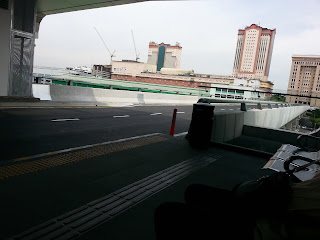Sekinchan Trip - 渔米之乡
Hello, it's been 2 weeks since I last posted. The word "lazy" caught me right at the beginning of the year. Not a good start. Unwilling to get lazy any further, here's the post I promised.
Right before my semester started, I went to a short trip to Penang for 3 days 2 nights. Although the main aim was Penang, we ended up going to a another 2 states. Thus, to be more accurate, it was a state a day.
The first place we went was Sekinchan (适耕庒), known for its paddy field and fishing village. That's how they got the beautiful name - 渔米之乡.
The first place we went was the iconic wishing tree that is located near Redang beach.


You can get the red cloth from the Dato Gong temple right beside the tree for any amount of donation. After you donate, write your name and your family name on the red cloth. Pray in front of Dato Gong and off to make your wish "fly" up high to the tree.
On the left of the tree full of wishes are some "innovated" swings. The old plastic swings give off a kind of old, relaxing village, which I kind off like it.
Right in front of the tree is a market that sells food and souvenirs.
As it was about lunch, we decided to stop at a nearby restaurant, which is also recommended by a lot of bloggers and the official website as well, Bagan Seafood Restaurant.
The restaurant, according to the owner, serves food that they catch and plant themselves. They have some specialties that you may want to try, but we ordered this (after careful consideration, I will only post those food that are special or exceptionally tasty, or else the whole post will be flooded with the same kind of food):
 |
| Fish cakes or is it fish tofu It's made of a combination of seafood |
We could also see blocks of building, where they rear swallows for bird nests.
The best time to visit according to the guides during the paddy processing factory visiting session if you want to see:
- green field: March, April, August, September
- yellow field: May, November
Well, in case you come at a bad timing like me, maybe you could satisfy your desire with this:
 |
| The shop/souvenirs store |
 |
| The complementary rice |
There will be a room prepared for you to watch some paddy planting videos. Therefore, it will be suitable for an educational trip.
There is also a paddy planting machine right outside the factory (in case you become curious after watching the video) :
I couldn't remember how many tonnes of rice are stored in the sack below (is it 1 ton or 5 tonnes?), but what I can remember is that if a person were to eat one whole sac, it would take about 50 years on average.
 |
| Packaging machine |
 |
| Colour sorter - remove black and immature rice using photoelectric technology |
 |
| Without the hull is brown rice; Only the endosperm remains is white rice (Which is why white rice always look like the little guy over there - incomplete oval) |
There are also some antiques on this factory and also an explanation of the origin of Sekinchan, which is really worth the read.
We also got to visit the Mango King farm which is located nearby. Again, we came at the wrong season and the fruits were not that sweet. But what I have tried, is still quite sweet. According to the lady, it is best to go around the paddy yellowing season (especially during school holidays), for mangoes.


Right after Sekinchan, off we went to Penang. A scenic view on the bridge.
As we arrived in Penang, we went for check in. We stayed at R Residence in Gelugor, which we booked on that day itself. It costs Rm 180/night for the family room (4 beds), which is worth it as they are cleaner, well-furnished and well decorated compared to the hotels that we have searched (it may also be cheaper). We originally booked a 3 beds room, but something happen so the owner switched us to the family room for the same price.
This place is convenient for those who travel with a car.
They have pictures of their rooms in their website. But, if you are scared that they are fake, here are the pictures that I took.
"My" room with veranda:


The Master bedroom:


The top floor:




 |
| Access card just like a hotel |
 |
| Dont forget the amazing garden |
For dinner, we decided to settle in a nearby restaurant - Pulau Tikus Market. Not for the hygienes, but where can you find the best locals food besides this kind of place? (This place is not the best yet, though)
This bread stuffed pork made by the grandmother is worth to try. Crispy and flavourful.
I have no idea what the dessert below is called but it is quite delicious. There are a lot of ingredients in it, such as longan, different kinds of agar, nuts,... It is really refreshing and delicious dessert for such a hot day.
And that's all about my first day. It turns out to be quite long due to the pictures, but hope you will find something useful to plan for your next holiday trip.
























Comments
Post a Comment